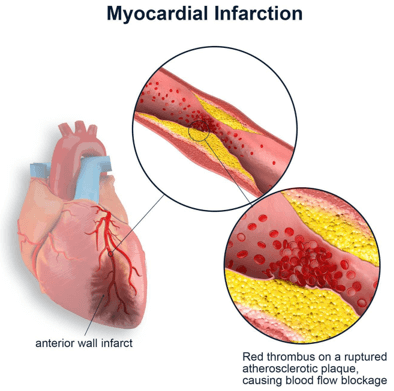The practical nurse (PN) is caring for a client with coronary artery disease who is admitted with intermittent chest pain. The admission laboratory results indicate elevations in troponin I and creatine phosphokinase myoglobin isoenzyme (CK-MB) levels.
What should the PN consider the most significant risk for this client on the second day of admission?
The lab results indicate myocardial damage, and the client is at risk for cardiac dysrhythmias
The client is at risk for pulmonary embolism, and lifestyle modifications need to be implemented.
The client is at risk for recurrent long-term angina pain and subsequent myocardial infarction (MI).
The lab results indicate risk factors for transient ischemic atack (TIA), and neurological vital signs should be monitored.
The Correct Answer is A
Troponin I and CK-MB are cardiac enzymes that are released into the bloodstream when the heart muscle is injured or necrotic. Elevated levels of these enzymes indicate that the client has suffered a myocardial infarction (MI) or heart atack. The damaged heart tissue can impair the electrical conduction system of the heart and cause abnormal heart rhythms or dysrhythmias, which can be life-threatening. The PN should monitor the client's cardiac status closely and report any changes to the charge nurse.
The other options are not correct because:
- The client is not at risk for pulmonary embolism, which is a blockage of a pulmonary artery by a blood clot or other material. Pulmonary embolism does not cause elevated cardiac enzymes, but it can cause chest pain, shortness of breath, and hypoxia.
- The client is not at risk for recurrent long-term angina pain, which is chest pain caused by reduced blood flow to the heart muscle due to narrowed or blocked coronary arteries. Angina pain does not cause elevated cardiac enzymes, but it can be a warning sign of an impending MI.
- The lab results do not indicate risk factors for transient ischemic atack (TIA), which is a temporary interruption of blood flow to a part of the brain due to a clot or plaque. TIA does not cause elevated cardiac enzymes, but it can cause neurological symptoms such as weakness, numbness, or speech difficulties.

Nursing Test Bank
Naxlex Comprehensive Predictor Exams
Related Questions
Correct Answer is D
Explanation
A) Incorrect- While notifying the healthcare provider is an important step to take after an error, it's not the first action the nurse should take. The immediate concern is the client's safety and well-being, so assessing the client for any adverse effects of the incorrect dose is the priority.
B) Incorrect- Documentation is important, but it's not the first action to take after administering an incorrect medication dose. The nurse should prioritize assessing the client for any adverse effects and ensuring their immediate safety.
C) Incorrect- Completing an incident report is an important step to document errors and prevent future occurrences, but it's not the initial action to take. First, the nurse should focus on the client's well-being by assessing for adverse effects.
D) Correct- Assessing the client for any adverse effects is the immediate priority when an incorrect dose of medication has been administered. The nurse's first concern is the safety and health of the client. Once the client's condition has been assessed and stabilized, further actions can be taken, such as notifying the healthcare provider and completing incident reports.
Correct Answer is ["B","C","E"]
Explanation
A) Incorrect- While hydration is important, this response doesn't directly address the client's question about the content and timing of meals.
B) Correct- Complex carbohydrates high in fiber content have a slower impact on blood glucose levels, promoting better glycemic control.
C) Correct- Bedtime snacks can be helpful to prevent nighttime hypoglycemia, but if heartburn develops, it may be necessary to modify the timing or content of the snack.
D) Incorrect- This response is not directly related to managing blood glucose levels or gestational diabetes.
E) Correct- Refined sugars can cause rapid spikes in blood glucose levels, so avoiding them helps maintain stable glycemic control.
Whether you are a student looking to ace your exams or a practicing nurse seeking to enhance your expertise , our nursing education contents will empower you with the confidence and competence to make a difference in the lives of patients and become a respected leader in the healthcare field.
Visit Naxlex, invest in your future and unlock endless possibilities with our unparalleled nursing education contents today
Report Wrong Answer on the Current Question
Do you disagree with the answer? If yes, what is your expected answer? Explain.
Kindly be descriptive with the issue you are facing.
